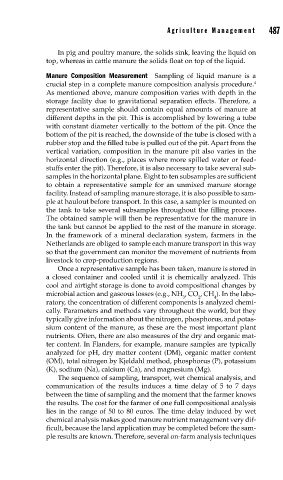Page 515 - Biosystems Engineering
P. 515
Agricultur e Management 487
In pig and poultry manure, the solids sink, leaving the liquid on
top, whereas in cattle manure the solids float on top of the liquid.
Manure Composition Measurement Sampling of liquid manure is a
crucial step in a complete manure composition analysis procedure.
4
As mentioned above, manure composition varies with depth in the
storage facility due to gravitational separation effects. Therefore, a
representative sample should contain equal amounts of manure at
different depths in the pit. This is accomplished by lowering a tube
with constant diameter vertically to the bottom of the pit. Once the
bottom of the pit is reached, the downside of the tube is closed with a
rubber stop and the filled tube is pulled out of the pit. Apart from the
vertical variation, composition in the manure pit also varies in the
horizontal direction (e.g., places where more spilled water or feed-
stuffs enter the pit). Therefore, it is also necessary to take several sub-
samples in the horizontal plane. Eight to ten subsamples are sufficient
to obtain a representative sample for an unmixed manure storage
facility. Instead of sampling manure storage, it is also possible to sam-
ple at haulout before transport. In this case, a sampler is mounted on
the tank to take several subsamples throughout the filling process.
The obtained sample will then be representative for the manure in
the tank but cannot be applied to the rest of the manure in storage.
In the framework of a mineral declaration system, farmers in the
Netherlands are obliged to sample each manure transport in this way
so that the government can monitor the movement of nutrients from
livestock to crop-production regions.
Once a representative sample has been taken, manure is stored in
a closed container and cooled until it is chemically analyzed. This
cool and airtight storage is done to avoid compositional changes by
microbial action and gaseous losses (e.g., NH , CO , CH ). In the labo-
3 2 4
ratory, the concentration of different components is analyzed chemi-
cally. Parameters and methods vary throughout the world, but they
typically give information about the nitrogen, phosphorus, and potas-
sium content of the manure, as these are the most important plant
nutrients. Often, there are also measures of the dry and organic mat-
ter content. In Flanders, for example, manure samples are typically
analyzed for pH, dry matter content (DM), organic matter content
(OM), total nitrogen by Kjeldahl method, phosphorus (P), potassium
(K), sodium (Na), calcium (Ca), and magnesium (Mg).
The sequence of sampling, transport, wet chemical analysis, and
communication of the results induces a time delay of 5 to 7 days
between the time of sampling and the moment that the farmer knows
the results. The cost for the farmer of one full compositional analysis
lies in the range of 50 to 80 euros. The time delay induced by wet
chemical analysis makes good manure nutrient management very dif-
ficult, because the land application may be completed before the sam-
ple results are known. Therefore, several on-farm analysis techniques

